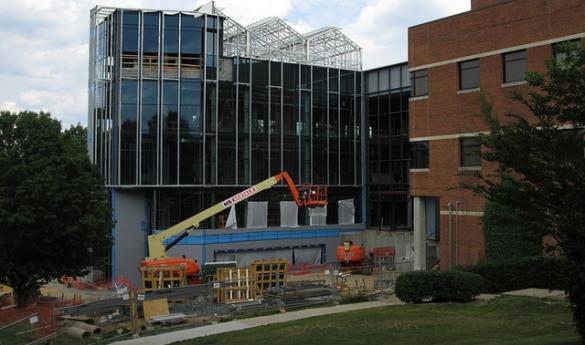OPINION: Campus construction is a cause for frustration
As the semester begins, prospective students stroll along the sidewalks of campus with their parents. Some of these school-scouts have likely visited Virginia Tech or The University of Virginia, two schools which boast stately architecture and a beautiful symmetry. Though I was not able to visit any universities before I enrolled at Mason, my first impression of the school was that it seemed park-like. Winding concrete sidewalks took students on tiny adventures to undiscovered buildings with odd names.
Though some students may find themselves distraught when their Virginia Tech friends comment on the Hogwarts-like architecture of their own classrooms, I find Mason’s wooded and informal feel quite refreshing. In a way, I feel immersed in the inner-workings of Northern Virginia. I go to class in a plethora of buildings, each with its own personality. Not every building on campus has to match, and the lack of a defined gate or entrance to the university also assists the symbiotic city and university narrative.
I would like to think that the personality of George Mason University is partially defined by both its presence in Northern Virginia and its somewhat indistinct and unobtrusive architecture, blending into the vast expanses of the metro area with ease. But I am more comfortable making the claim that our university is defined by muddy, untraversable routes of unnavigable detours. While facelifts to buildings are spectacular—especially Planetary Hall, formerly Science and Tech I, which had no personality—I hardly see how it’s necessary to renovate everything at once.
For example, my typical route to practice begins at the Student Apartments and ends at the Field House. I cross Patriot Circle and walk towards PV Lot, cross behind the RAC Field and continue through what I endearingly call “tiny woods” to cross Ox Road. Last week, however, I began my journey to the Field House and was misguided by some ambiguously placed fences. The detour led directly to what is possibly the only remaining tree in tiny woods, and it was clearly suggested I should not go around the fence. Tiny woods was gone, and this fence lied to me, which made me late for practice. On this same day, I was diverted from the Southside steps and bravely conquered the neighboring snowy hill on my way to The HUB. When I got to The HUB, I was freezing and trembling and everything that comes along with being cold, inconvenienced and sad. I saw the warm, comfortingly efficient Office of Student Involvement just inside the doors of the second level and, upon tugging, the door didn’t open. Even the door to my office building was under construction!
Students having to memorize one detour a month would not be so bad. If students, however, are meeting a new detour every week, it becomes frustrating quite quickly. Being hindered by construction is wildly inconvenient, but the benefit of newly constructed buildings is extraordinary—so what, you may ask, am I up in arms about? I may be naïve in my suggestion, but what would happen if the university completed one project at a time? If the school is in a constant state of renovation, it’s almost as if many of our campus buildings do not even exist. I have not been in Exploratory Hall since it had a less confusing name, Science and Tech II. And while some renovations, such as the evolution of Student Union II into The HUB, are less obtrusive than others, it seems more logical for Mason to finish one large-scale project before starting another. They could have finished University Hall before they started conjoining the Science and Tech buildings. It seems to be more fiscally responsible for them to finish conjoining Exploratory and Planetary halls before mowing down tiny woods to build another road. Can resources not be aimed towards one project at a time?
Would you like to respond to this article with a letter to the editor? If so, send an email to opinion@connect2mason.com with the subject line "letter to the editor." Please specify to which article your letter is responding.
Opinions are those of the author. They do not necessarily reflect the views of Connect2Mason.

